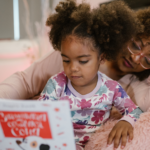Your first grader proudly reads aloud: “The cat sat on the mat.” But when you ask what happened in the story, they stare blankly. Sound familiar? This is the classic challenge of early reading comprehension. Children can decode words but struggle to understand their meaning. Understanding what reading comprehension looks like in first grade helps parents support this crucial transition from learning to read to reading to learn.
What Reading Comprehension Means in First Grade
First grade reading comprehension is quite different from what we expect in older students. At ages 6-7, children are still developing the cognitive skills needed to hold information in memory, make connections, and think abstractly about text.
Reading comprehension in first grade focuses on literal understanding of simple texts. Children should be able to identify basic story elements like characters, setting, and main events. They’re learning to connect pictures with text, use context clues, and make simple predictions about familiar story patterns.
The goal isn’t deep analysis or complex inference-making. Instead, first graders are building foundational comprehension skills:
- Understanding that text carries meaning
- Connecting spoken language to written words
- Recognizing that stories follow logical sequences
Most first graders can handle books with 50-100 words, simple sentence structures, and familiar vocabulary. They’re transitioning from memorizing sight words to actually reading connected text, which means comprehension skills are just beginning to emerge alongside decoding abilities.
Remember that many first graders are still working hard to decode words fluently. When children use most of their mental energy figuring out what words say, they have less capacity left for understanding what those words mean together.
Realistic Expectations for First Grade Comprehension
Understanding appropriate expectations prevents frustration for both parents and children. First grade comprehension skills develop gradually throughout the year, with significant variation between children.
Beginning of First Grade: Children can identify the main character in a simple story, tell you what happened at the beginning and end, and connect obvious pictures to text. They might retell a story using mostly the pictures as prompts and struggle to distinguish between important and unimportant details.
Middle of First Grade: Students can retell simple stories in sequence, identify basic problems and solutions, and make predictions based on pictures or familiar story patterns. They begin connecting stories to their own experiences and can answer simple “who,” “what,” and “where” questions about the text.
End of First Grade: Children can summarize main events from beginning to end, identify story lessons or morals, make simple predictions about what might happen next, and compare characters or events within a story. They’re beginning to make inferences based on clearly stated information.
Throughout first grade, children should be reading books where they can decode at least 90% of the words independently. If they’re struggling with too many unknown words, comprehension becomes nearly impossible because all their mental energy goes toward decoding.
Most first graders can handle books like “Frog and Toad,” “Henry and Mudge,” or “Mercy Watson” series by the end of the year. These books have simple plots, familiar vocabulary, and clear picture support.
Build Comprehension Through Daily Reading
The most powerful tool for developing first grade comprehension is regular, interactive reading time. Both reading aloud to your child and listening to them read builds different aspects of comprehension.
During Read-Alouds: Choose books slightly above your child’s reading level to expose them to richer vocabulary and more complex story structures. Pause to ask simple questions: “What do you think will happen next?” or “How do you think the character feels?” Point out connections between the story and your child’s experiences.
During Independent Reading: Let your child choose books at their comfort level. After reading, ask them to tell you about the story in their own words. If they struggle, help by asking specific questions:
- “Who was in the story?”
- “Where did it happen?”
- “What was the problem?”
Keep discussions natural and brief. First graders have short attention spans, so a few minutes of conversation about the book is more effective than lengthy question sessions.
Use picture walks before reading new books. Look through the illustrations together and predict what the story might be about. This previewing builds background knowledge and gives children a framework for understanding.
Simple Strategies That Make a Big Difference
Connect to Experience: Help children link stories to their own lives. If you’re reading about a character who loses a tooth, talk about when your child lost a tooth. These connections make abstract story events more concrete and memorable.
Act It Out: First graders learn through movement and play. Act out story events, use different voices for characters, or draw pictures of important scenes. These activities help children visualize and remember story elements.
Use Graphic Organizers: Simple visual tools help organize thinking. Draw a basic story map with boxes for “beginning,” “middle,” and “end,” or create character charts showing what characters look like, feel, or do.
Practice Retelling: Encourage your child to retell stories to family members, stuffed animals, or pets. Retelling strengthens memory and helps children identify the most important story elements.
Ask the Right Questions: Focus on literal comprehension questions first:
- “What happened in the story?”
- “Who were the characters?”
- “Where did the story take place?”
Save “why” and “how” questions for when your child masters the basics.
Set Your Child Up for Reading Success
First grade reading comprehension is about building foundations, not mastering complex skills. Children who can identify story elements, retell simple events, and connect books to their experiences are developing the skills they need for future reading success.
Celebrate small victories: when your child remembers a character’s name, predicts what happens next, or explains why something happened in a story. These moments show that comprehension is developing, even if progress seems slow.
The goal is to raise a child who sees reading as meaningful and enjoyable. When children understand that books tell interesting stories about people, places, and ideas, they’re motivated to keep reading and learning.
Ready to support your first grader’s reading comprehension with research-based instruction that meets them exactly where they are? Start your free 7-day trial of the Reading.com app and discover how systematic, engaging lessons help children truly understand and enjoy what they read.





